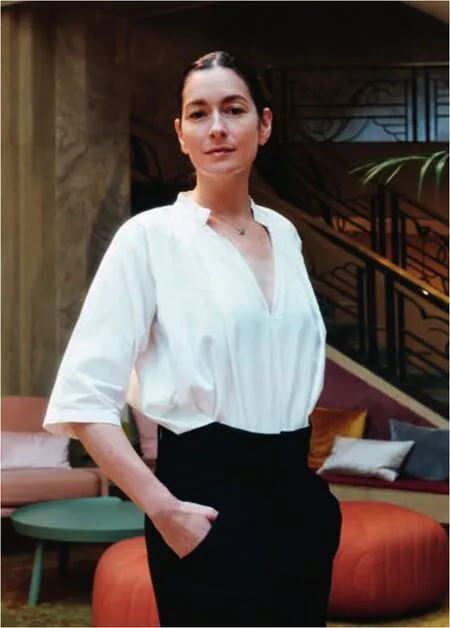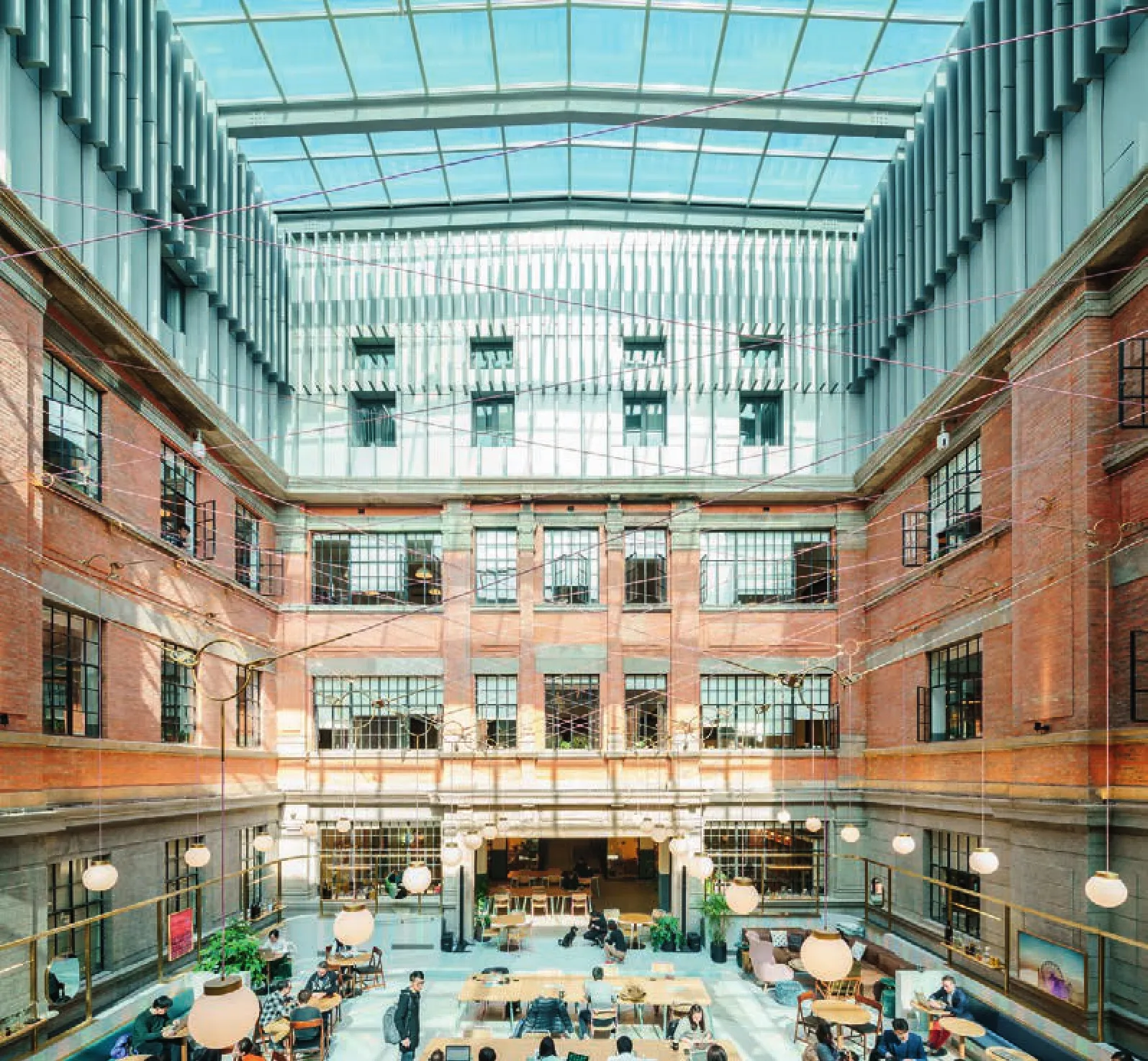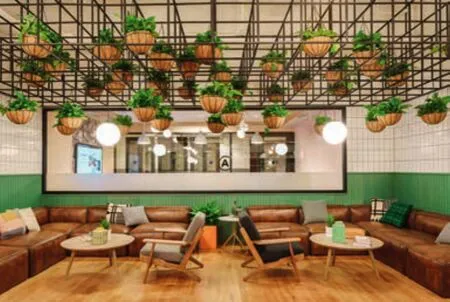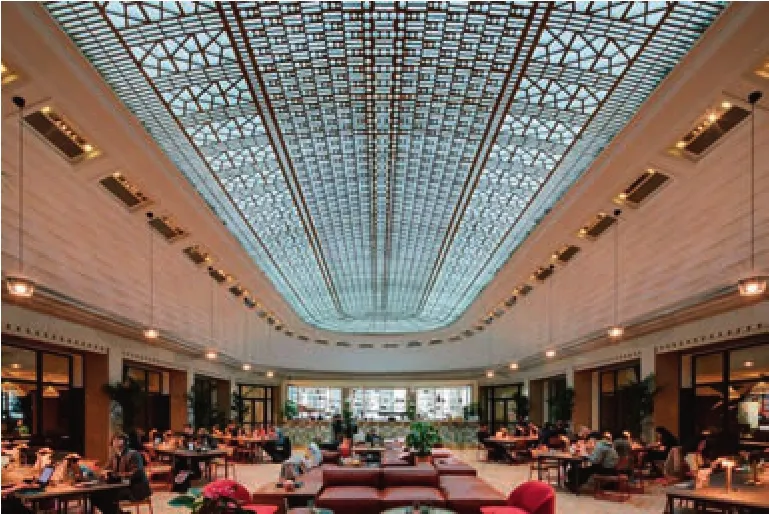WeWork室内设计主管布里特妮·哈特访谈
叶扬 采访/Interviewed by YE Yang

1 布里特妮·哈特/Brittney Hart

2 WeWork英国伦敦老街共享空间/WeWork Old Street Commons London, UK
2018年2月,我们对WeWork室内设计主管布里特妮·哈特1)进行了邮件采访。
WA:WeWork是世界上 “联合办公空间” 设计最为成功的公司。能告诉读者你们对于“联合办公”的定义吗? “联合办公”对你们来说有什么不同的意义?
布里特妮·哈特(BH):WeWork不仅是个“联合空间”,我们是一个面向创作者的平台。通过实体和虚拟的产品向全世界20多万名会员提供空间、社区和服务。我们相信,通过容纳了极佳设计与技术的空间将人与人联系起来——最重要的是通过社区——我们使人们的工作和生活更加人性化。
WA:在您看来,“联合办公空间”对于城市的作用是什么?
BH:人们搬进城市,寻求社区、目标和机遇来创造他们的生活。工作的性质正经历着一种宏观的文化转变。越来越多的人们跨越代际、种族和地域,以期实现个人成就,这意味着他们在充满活力的环境中做着自己所热爱的工作,其他人也在努力把创意变成现实。
在WeWork,我们专注于将建筑和空间转化为充满创造性、专注性和连接性的动态环境。它不仅是一个很好的工作场所,我们还通过创造有意义的令人难忘的经历,给会员业务带来积极的影响,从而为工作带来了革命性的变化。一旦会员加入WeWork,他们可以同时受益于所有这些服务设施和增值体验。
WA:可以请您描述一下联合办公空间的设计过程吗?这与为一家单独的公司设计传统的工作空间的过程是否不同?
BH:我们的设计团队投入了大量的精力来添加特殊的细节,使用定制的家具和灯光,创造出一种具有综合性与层次感但又容易接近的空间。无论是通过定制的艺术品、自定义的材料和色板、整个空间的流动和布局、甚至是办公桌在办公室里如何摆放——我们正在促进和推动那些与建筑相互交织的有意义的体验,并将其带入到生活中。
我们也专注于为会员提供能够恰当融合灵感与功能的空间。在WeWork,我们打造了很多成功的空间,这些空间是开放的,但却有不同的工作方式和互动方式。休息区往往挤满了人,很多人聚集在一起交谈,发出嗡嗡声,产生了一种奇妙的有感染力的能量。个人办公室和会议室构成了一个中间地带,比公共区域更私密也更安静,但仍然会产生一种与周围人的行为活动密切相关的感觉。电话间或小型讨论区为会员提供了远离喧嚣和活动的喘息之机。
为单独的公司做设计可能需要一些定制,比如更大的会议室,或者一个专门用于藏书的空间。但无论你是自由职业者、小公司还是大公司,我们的目标是创造一种环境,能够为人们提供空间并提供一种彼此互动的方式。
WA:设计过程中您最关心的重要部分是什么?哪一部分最具有挑战?您如何为自己的空间选择建筑师或室内设计师?
BH:社群是WeWork的催化剂,因此我们专门把空间设计成能激发会员间协作和互动的形式。我们希望自己的空间能平易近人,且使用了那些对空间、邻里和社区都很可靠的自然材料。
我们的目标是提供全面的会员驱动的体验,这意味着需要设计对不同类型的公司和工作者来说都实用且令人愉快的空间。当人们走进世界上任何一家WeWork的办公空间——都能感受到直接且明显的能量,这不是偶然的,而是基于设计的必然。虽然每个场所都是独一无二的,但它毫无疑问仍然是WeWork理念的体现。现如今,打造高效的工作场所是为了尽可能提供最好的体验,我们希望会员在进入空间时,清楚地知道他们身在WeWork之中,但它又是独一无二的,因为WeWork使空间具有上海、墨西哥城或巴黎等各自不同的地域特质。
WA: WeWork is the most successful company for the "co-working spaces" in the world. Could you tell our readers what is your definition of "co-working"?Does it have any some different meanings for you?
Brittney Hart (BH): WeWork is more than just"co-working spaces." We are a platform for creators,providing over 200,000 members around the world with space, community, and services through both physical and virtual offerings. We believe that by connecting people through our spaces with the best of design, technology, and most importantly, our communities, we humanise the way people work and live.
WA: What is the role of "the co-working spaces" for the cities in your views?
BH: People are moving to cities, seeking community,purpose, and the opportunity to create their life's work. The nature of work is changing and there is a macro cultural shift taking place. More and more people – across generations, races, geographies – want personal fulfilment. This means working on projects they're passionate about an energetic environment where others are also working hard to bring their ideas to life.
At WeWork, we focus on transforming buildings and spaces into dynamic environments for creativity, focus, and connection. It becomes more than just having the best place to work, we are revolutionizing work by creating meaningful and memorable experiences that positively impact on our members' businesses. Once our members enter a WeWork, they can benefit from all of these valueadded and services experiences simultaneously.
WA: Can you describe the process of designing a co-working space for you? Is it different with the process of designing other traditional work spaces for a single company?
BH: Our design team puts a lot of energy into adding special details, creating custom furniture and lighting to create spaces that feel complex and layered but accessible. Whether it's through custom artwork, defining the materials and colour palette,the flow and layout of the entire space, or even how the desks are arranged in an office, we're facilitating and driving experiences that intertwine with the architecture that are meaningful and bring them to life.
We also focus on providing our members with spaces that have the right mix of inspiration and function. There has been a lot of success at WeWork in creating spaces that are open but programmed with different types of ways of working and interacting. Our lounge areas tend to be bustling with lots of people congregating and buzzing about those yields a fantastic, infectious energy. The individual offices and conferences rooms constitute a middle ground and offer more privacy and quiet than the common areas but still generate a feeling of closeness with the activity of people working around them. Phone booths, or smaller breakout areas provide members some respite from the bustle and activity.
Designing for a single company might require some customisation like a larger conference rooms,or a dedicated space for a library for example. But whether you are a freelancer, a small company or a large corporation, our goal is to create environments that offer people ways to interact with the space and with each other.
WA: What are the important parts which you care most about in the design? Which part is most difficult? How did you choose architects or interior designers for your spaces?

3 WeWork中国上海威海路共享空间/WeWork Weihai Rd Commons Shanghai, China
WeWork的独特之处在于,我们内部有一个全球化的复合型团队,拥有600多名室内设计、建筑、产品设计、平面设计、工程、研究、物流、构造、运营、供应链和设施等领域的专家。他们来自于纽约、旧金山、上海、伦敦、布宜诺斯艾利斯、孟加拉和东京。在同一个独立组织之下的内部设计团队和开发团队使WeWork成为(如果不是唯一的也是)少数几家全身心专注于在世界各地构建美好空间的公司之一。
WA:到目前为止,世界范围内共有多少个WeWork办公空间?中国有多少个?
BH:WeWork在全球拥有200多个实体空间,建筑类型包括历史性的旧建筑和高级办公楼等。在中国,目前有12个,如北京、上海和香港。
WA:使用者最喜欢哪一个空间呢?原因是?
BH:遍布世界的空间有200多个,很难说哪一个是最好的。对我们的会员来说,WeWork设计的每一个空间都是独一无二的,且获得成功的原因各不相同。
WA:商业上最成功的空间是哪一个?促使联合办公环境获得成功的因素是什么?
BH: 每个空间都有其独特性且成功的原因各不相同。我们认为自己是一家以地域性操作为方向的全球化公司。无论是在柏林还是在圣保罗的WeWork,我们的最终目标都是一样的——通过优秀的设计为社区和协作创造机会。
在WeWork,我们非常重视成为当地社区的一分子,而不只是把WeWork的理念扔到既有城市当中。在选定目标建筑之前,设计和研究团队就开始工作了,我们实地调研,了解这片区域和邻里。团队对建筑本身的了解,对区域历史的了解,以及对社区和邻里的了解都可以转译成为场所特定的设计元素(如定制的艺术品、家具等)。
WA:您认为联合办公空间能改善现代工作的流程吗?在效率、沟通、可移动性或成本控制方面它是如何起作用的?
BH:当然有改善,但是设计任何工作空间的关键在于,要明确你在为谁做设计。这可能是显而易见的事实,但倾听始终是关键,你获得的信息和你所提供的信息同等重要。在WeWork,我们一直在寻找优化会员体验的方法。环境里有某种力量,使志趣相投的人们能富有激情地对待生活和工作。
WA:从联合办公空间中获得的创意可以应用到传统的办公空间吗?
BH:WeWork一直都将自己视作一个面向创作者的平台,在开始进行任何项目设计时,会员都是我们所考虑的重点。这似乎是显而易见的,但这对于理解我们在为谁而设计有重要的价值。工作的本质在不断变化,但人们如何工作或人际之间如何交往,是许多职场设计行业正在研究且仍在努力解答的命题。
我们的会员涵盖了广泛的群体且其需求各不相同。我们一直在寻找解决方案。这意味着我们所有的会员进入WeWork打造的空间后,都要集中注意力去工作,并与他们所在的社区进行互动。我们的内部研究团队能够获得会员在空间中的实时反馈,并查看空间性能的各项数据。反馈后期又汇总给设计师,使得我们可以将设计进行迭代和优化,也使得我们在世界各地不断进行更多的空间设计。无论是调整会议室的大小、更换椅子的种类,还是改变壁纸的设计,我们一直在努力改进,且希望能更好地整合使用者的经验。□

4 WeWork英国伦敦帕丁顿共享空间/WeWork Paddington Commons London, UK

5 WeWork美国洛杉矶大道共享空间/WeWork Promenade Commons Los Angeles, USA

6 WeWork中国上海延安路共享空间/WeWork Yan'an Rd Commons Shanghai, China
BH: Community is a catalyst for WeWork, so we design our spaces to inspire collaboration and interaction among the members. We want our spaces to feel approachable and use natural materials that feel honest to the space, the neighbourhood, and community.
Our goal is to provide an inclusive memberdriven experience, which means designing a space that is both useful and enjoyable to diverse types of companies and workers. When someone walks into a WeWork – in any location around the world – there is an immediate and palpable energy. This is not accidental, it's by design. So while each location is unique, it's still distinctly WeWork. Today, creating effective workplaces is about providing the best experiences possible. We want our members to enter our spaces knowing they are in a WeWork but it's unique because it has qualities that make it feel like a WeWork in Shanghai or Mexico City or Paris.
WA: By now how many WeWork spaces in the world? And how many in China?
BH: WeWork has over 200+ physical locations around the world that range in footprint and building types that include historical and Class A towers. We currently have 12 locations open in China: Beijing, Shanghai, and Hong Kong.
WA: Which one do users like most? And why?
BH: With over 200+ locations around the world, it's hard to single out a location. Again, each WeWork is unique and is successful for different reasons for our members.
WA: Which space is the most successful in commercial term? What makes the co-working environment successful?
BH: Each space is unique and is successful for different reasons. We see ourselves as a global company with a local playbook. The goal is always the same whether we're designing a WeWork in Berlin or Sao Paulo – to create opportunities for community and collaboration through good design.At WeWork we put a huge emphasis on becoming a part of the local community. We're not just dropping the WeWork culture into an existing city. Before a building is even selected, our design and research teams get to work. We visit the site,get to know the area, and neighbourhood. What our teams learn about the building, history of the area,the community and neighbourhood can translate into design elements (i.e. custom artwork, furniture)specific to that location.
WA: Do you think the co-working spaces improve the modern work process? How does it work on productivity, communication, mobility or cost control?
BH: Absolutely, but the key to designing any workspace is understanding who you are designing for. It may be obvious to state, but listening is always key. What you do with the information you're provided is equally as important. At WeWork, we are always looking for ways to improve our members'experiences. There's a power to being around likeminded individuals pursuing their life's work and passion. By connecting them with each other in our spaces, we're aiming to nourish productivity,progress, and inspiration.
由识别框架Θ的所有子集组成的集合称为Θ的幂集,记作2Θ。基本信度分配函数是从集合2Θ到[0,1]的映射。m0(A)为A(A⊆Θ)的BPA值,表示证据对结果为A的信任程度。
WA: Have there been something creative gained from the co-working spaces can be applied to the traditional work spaces?
BH: WeWork has always identified itself as a platform for creators, and when we start designing any project we're thinking about our members. It seems obvious to state, but there is significant value to understanding who we design for at WeWork.The nature of work is constantly changing but how people work or interact in them is something many in the workplace design industry are studying and still trying to understand.
Our members traverse a wide demographic and their needs are different. We're always looking for solutions that mean all our members have to do is come to a WeWork to focus on work and interact with their community. We have an internal research team getting real-time member feedback on our spaces and looking at data around how our spaces perform. This feedback comes back to our designers,and we continue to iterate our designs as we continue to add more locations around the world.Whether it's modifying the size of a conference room, chair types, or a wallpaper design, we are always working to improve, and hopefully better,the experience for those utilizing our spaces.□

7 WeWork法国巴黎老佛爷共享空间/WeWork La Fayette Commons Paris, France(1-7图片来源/Courtesy of WeWork)
注释/Note
1)布里特妮·哈特,WeWork室内设计主管,加利福尼亚州立大学洛杉矶分校硕士,负责把控新项目美学层面的研发及创新,以改善WeWork现有及未来会员的体验。与此同时,她也是Husband Wife的联合创始人和主创设计师。/Brittney Hart, Head of Interior Design, WeWork, earned her Master of Architecture from the University of California, Los Angeles. She is responsible for developing and creating the aesthetics of new projects to enhance the WeWork experience for its current and future members. At same time, she is the co-founder and principal for Husband Wife.

